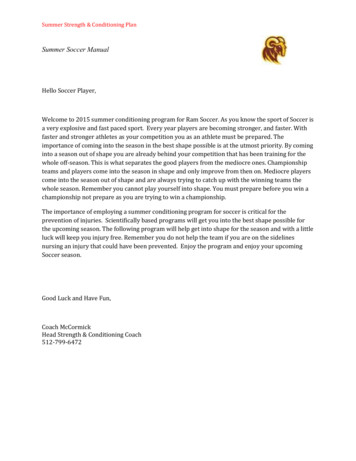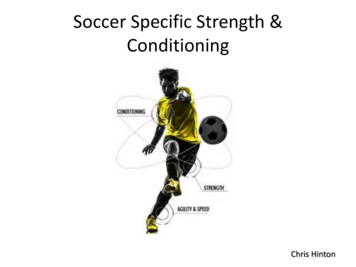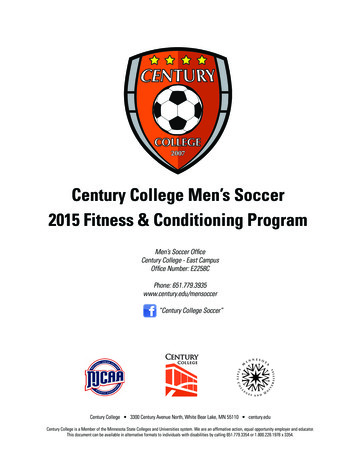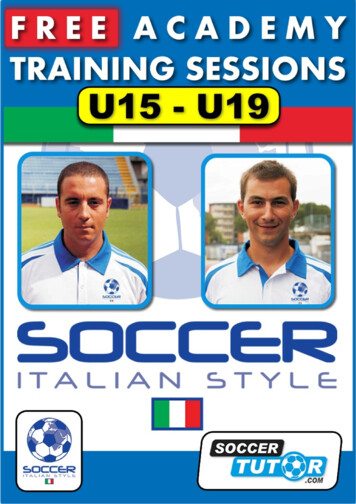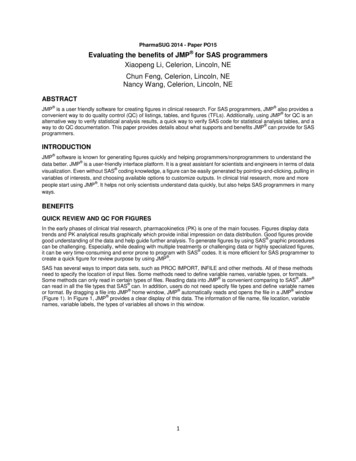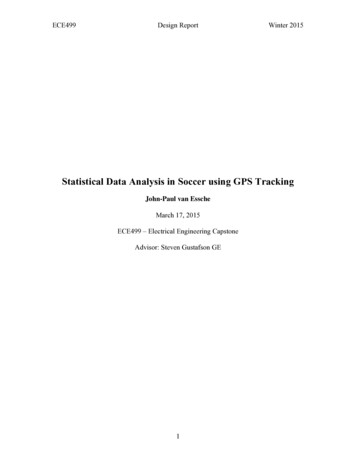
Transcription
ECE499Design ReportWinter 2015Statistical Data Analysis in Soccer using GPS TrackingJohn-Paul van EsscheMarch 17, 2015ECE499 – Electrical Engineering CapstoneAdvisor: Steven Gustafson GE1
ECE499Design ReportWinter 2015Report Summary:The Senior Capstone Project is the culmination of over three years ofundergraduate electrical engineering instruction along with prerequisite courses inmathematics and physics. The diligent study of these concepts has allowed for theapplication and design of a project that combines a passion for both electrical engineeringas well as soccer.The overall design goal of this project is to produce a position tracking system forsoccer players on field with a clear intention of providing a data map to their on fieldpositioning and the distance they travel during a training session. By tracking the precisemovement of an individual player on the field, data can be retrieved to identify whetheror not the player is playing in their position adequately. After a training session or game,software can then provide a data map of players indicating where the individual waslocated over the course of their particular play. In higher-level competitions andprofessional soccer, having this clear-cut data can be the difference between a win andloss as many players have different strengths that suit to their style of play and position.Additionally, powerful data analysis can assist managers and coaches to summarize thebehavior pattern of both the competitor and home team. With statistics regarding eachplayer, calculated predictions can be made and an individual’s weaknesses can beidentified.Having specific data allows coaches to come up with precise strategies forindividual athletes to improve themselves, as well as game plans to maximize the strengthof the team to counter their opponents. During a session, each individual player will havea location recognition device attached to either their shirt or around their arm. Within2
ECE499Design ReportWinter 2015soccer, certain players may have high work rates and be in great physical form, but theymay be playing either out of position or be too stationary, which is not always clearlyperceivable from a coach’s point of view. Ultimately, the objective of the positiontracking system is to provide managers and coaches with defined data that can be used todetermine which players can be placed into each position to maximize their performanceon the field. There is definitely a motivation to bring the technology to youth cluborganizations as well as competitive soccer leagues to provide coaches with clear data sothat calculated decisions can be made on how certain players should be positioned.Upon submission of this technical report, a GPS unit has been successfullyconstructed and tested, which can be used for tracking of player movements in soccer.The GPS module on the unit can log data on a player’s speed, distance travelled, andposition when a satellite fix is received. After filtering in the logged data, the softwaredisplays the positional track of the player during a training session, while also providing aspeed plot and some practical statistics relating to soccer for the user.3
ECE499Design ReportWinter 2015Table of Contents:ChapterPageReport Summary . 2Table of Figures and Tables . 5Introduction . 6Background . 9Design Requirements . 14Design Alternatives . 19Preliminary Proposed Design . 22Initial Design and Construction .28Final Design and Implementation . 30Performance Estimates and Results . 41Production schedule . 45Cost Analysis . 47Discussion, Conclusions, and Recommendations . 49References . 52Appendix . 53User’s Manual . 53Code . 554
ECE499Design ReportWinter 2015Table of Figures and Tables:Figures:Fig. 1: Position Tracking of Players . 7Fig. 2: Top-Level Block Diagram of Proposed System . 23Fig. 3: GPS Module connection to Arduino . 24Fig. 4: Layout of Software Output including Performance statistics . 26Fig. 5: Soldering the shield with pin headers . 32Fig. 6. Schematic of the Adafruit Ultimate GPS Shield . 33Fig. 7: Diagram of finalized GPS Unit in enclosure . 35Fig. 8: Raw GPS Data “NMEA Sentences” . 36Fig. 9: Tab-delimited GPRMC and GPGGA data . 37Fig. 10: Tab-delimited GPGGA fix data . 38Fig. 11: GPS Column data imported to Matlab . 38Fig. 12: Importing Variable Name Data . 39Fig. 13: GPRMC and GPGGA Variable Names . 39Fig. 14: 50 Yard Sprint on Bailey Field . 42Fig. 15: Test Statistics from 50 Yard Sprint . 43Fig. 16: Training Session Field Data . 43Fig. 17: Test Statistics from training session . 44Fig. 18: Initial Design Project Schedule . 45Tables:Table 1: Design Requirements . 18Table 2: Implemented Schedule for Senior Design Project. 46Table 3: Component Expenditures . 475
ECE499Design ReportWinter 2015Introduction:In competitive soccer at the club and varsity level, it is very difficult for managersto assess every player on the field equally as each player is moving concurrently in aspecialized position. In a match, managers and coaches are not able to keep track of alleleven players at once. My project aims to provide greater insight to coaches in theirdecision-making in order to assess players better on the field. By having quantifiabledata regarding each player, coaches can make more informed decisions on who to includein the starting lineup and how players can improve their positioning on the field. Becauseeach player is assigned to their position and expected to complete a specific task, it canbe challenging to pinpoint distinct strengths and weaknesses in a player’s game.First, every competitive manager has a different approach to how they want totheir team to line up. If an individual player does not meet the requirements of amanager’s system, they are likely to be assigned to a role on the bench, but if a player cancapitalize on their opportunities consistently, they will be given a starting roll. At thecompetitive level, the conventional team formation is a 4-2-3-1, which consists of fourdefenders, two defensive midfielders, three attacking midfielders and one forward. Eachplayer at the competitive level has considerable experience and is assumed to meet theirassigned position. A defender’s task is to keep the ball away from opponents in aprotective manner and prevent the opposing forwards from passing and receiving the ball.Defending requires individual players to work hard, be quick to anticipate the movementand passing of opponents, and position themselves as to not allow ample space to pass forthe opposing team. Midfielders tend to be well-rounded players; however, their taskrequires greater running and movement, as they have to bring the ball up and prevent the6
ECE499Design ReportWinter 2015ball from reaching their defenders when dispossessed. Forwards are positioned closest tothe opponent’s goal and they have to be able to distract defenders and receive the ballwell to create scoring opportunities by positioning themselves properly. Individualpositioning is very important as players need to be able to make runs into open space toreceive the ball and position themselves correctly as to not allow the opposing team tolink together too many passes. To highlight the challenge that a manager may have intrying to track each of his eleven field players, Fig. 1, which tracks player positionsduring a Professional soccer match, can be observed below.Fig. 1: Position Tracking of PlayersBy having a clear data map for the positioning of each player during a trainingsession or match, coaches can gain greater insight about their individual players’strengths and how their team can utilize the data to improve their positioning. Thus, themotivation for this project was to provide managers and coaches, specifically for soccer,with informative statistics that could aid them to make better decisions and better instructtheir players. For team management, this data can be used not only to analyze an7
ECE499Design ReportWinter 2015individual player’s performance, but also to provide team-wide data to see how much theteam is moving together as a unit when they possess the ball. The data can then be usedfor managers to ascertain which players are faltering and strive to help them regain theirform, based on the combined individual and team data.The overall objective is to provide greater insight to coaches in their decisionmaking in order to assess players better on the field. Due to the quick, aggressive pace ofthe matches in higher-level competitions, managers and coaches are only able to clearlyfocus on a group of players and they are not able to track each player’s positioningsimultaneously. Data regarding the speed of player’s movements, as well as theirproximity with each other, can clearly assist coaches and allow them to make betterinformed decisions.The remainder of this design report is organized comprehensively as follows.First, the paper focuses on the history of statistics in European football (soccer), anddiscusses the different technologies used to gain viable performance statistics in soccer.Second, the design requirements section outlines the specific requirements andcomponents that the design must satisfy in order for the system to be useful for coaches.In addition, the design requirements detailed the design process and goals as well aspotential costs. Third, the next section examines the alternative designs and technologiesconsidered for each component of the system. Fourth, the preliminary proposed designsection explains the complete design of the system and its underlying components andparts. The project specifications will be presented in a comprehensive manner, as to gaina full understanding of the general concept of the project.8
ECE499Design ReportWinter 2015Background:Within recent years, statistics relating to soccer as well as many other sports haveskyrocketed as a result of innovative advances in technology such as improvements indetection software, new statistical regression applications, as well as new, cost-effectiveGPS sensors and accelerometers [4]. The level of detail in data collection adds anotherdimension to the world of soccer, which allows for more innovative broadcast coverageand engaging sports journalism as well as better professional data analysis. Managers atthe competitive level are always keen to obtain access to the most useful data in order toproduce a calculated winning strategy. Success can never be fully planned in soccer;however, innovative technology can definitely provide teams with better data to improvetheir performance.The key performance metric I am observing within my senior project is usingGPS to estimate speed, and positioning of players on field. Positioning of players withinsoccer refers to the process of determining a player’s precise location on the field overthe course of a match or training session. For each assigned position, a player mustimplement a specific task successfully in order for the team to function well as a unit.Each manager has a different playing system, which may not cater to every player at first,but having a better sense of positioning on the field can educate players on how toimprove as a team as well.There have been several previous solutions that were used to track positioning andother performance metrics within soccer in recent years. First, with the development ofdigital camcorders in the early 1980s, managers and coaches of teams have used video towatch replayed games and observe which players are playing in their respective positions9
ECE499Design ReportWinter 2015properly. Watching recorded games can certainly allow coaches to get a better sense oftheir team strengths and weaknesses; however, the one clear limitation to watchingrecorded gameplay is that it can be very tedious and not conducive for time. By beinglimited to watching recorded gameplay numerous times to accurately analyze eachplayer, managers are also limiting their teams to time that could be better spentimplementing specific training drills and instructions in practice.Another example of positioning technology using for statistical performance datais radio frequency identification (RFID). RFID is essentially data collection technologymainly used for object identification and tracking, in which the system is comprised of areader module, which modulates data and commands into an RF signal, as well as anantenna for signal transmission [3]. Most RFID tags have many capabilities and can bevery practical; however, their clear limiting factor is their range and they tend to be onthe expensive side. Another main constraint of RFIDs is tag distribution on accuracy andprecision of passive RFID positioning systems are tag density and tag distance. The readrange of the RFID system depends on the frequency, in which the range generallyincreases as the frequency increases. Active RFIDs, which contain built-in batteries,have greater range in comparison to passive RFIDs, which do not have a built-in energysource; however, they are not as cost-effective as other sensor devices and require apermit to operate as well. Clearly, for RFID to function, a user must be within range of aRFID reader, and both the user and the reader must be operating on the same frequency.In early 2012, local Bundesliga soccer clubs in Nurnberg, Germany, implementedand tested an RFID-based system provided by the Fraunhofer Institute for IntegratedCircuits (IIS), that follows the movements of players and balls in order to provide10
ECE499Design ReportWinter 2015training data as well as automated score-keeping [7]. The RFID system developed,known as RedFIR, essentially provides team managers and trainers on how well playersperform, and whether they may require additional guidance. With the RFID system, eachplayer wears one or more battery-power RFID tags, which can be attached around one orboth of the player’s ankles, over the shin guard, or attached to the individual’s shirt.Each device transmits a unique ID number at a high frequency, using a proprietary airinterface protocol or set of standards that govern communication systems such as RFID.The readers positioned around the field capture each tag’s 2.4 GHz signal, and thenforward the specific ID’s location to a nearby computer. The Fraunhofer software thencalculates each device’s location based on triangulation and the time difference of arrival(TDOA) for each tag. The software can then provide data indicating where players arelocated at any given time during a game, and can enable coaches and referees to betterunderstand what occurred during particular plays. In addition, the software displays amap of the field, with an icon displaying each player and the ball, which can be reviewedfurther by team management and trainers. The RFID system developed by Fraunhoferoffers team managers a viable solution to determining how well each player performsduring a game, which can be used during practice to help team members with training;however, implementing the RFID system requires a substantial amount of hardware andcan cost tens of thousands of dollars, which certainly exceeds the budget of most nonprofessional competitive teams.For the 2014 World Cup in Brazil, the German Football Association (DFB)worked in collaboration with SAP Match Insights, to develop a high-performanceanalytic appliance tool to analyze players by processing vast amounts of data from video11
ECE499Design ReportWinter 2015footage [9]. Video footage is captured from 8 on-field cameras and thousand of datapoints are generated. The data is converted into simulations and graphs viewable on atablet or computer, enabling coaches and players to identify and assess key metrics suchas player speed, position and possession time in each match. These insights were thenused during pre-match preparations to improve player and team performance.In addition to enabling the German team to analyze its own performance, SAPmatch insights can help coaches and players to identify opponent’s strengths andweaknesses, as well as inform defensive tactics [9]. With this information, coaches canemploy specific strategies for individual players to improve themselves, and maximizethe team as a unit to counter their opponents. Like the RFID system presented before, thesoftware can extract data on individual players, and present it in an easily viewable andintuitive form, so that coaches can assess the tempo and position of players quickly.Again, the main overall problem is that most team managers at the competitive level donot have access to such technologies that allow for accurate sensing of players in anintuitive manner. These products are sustainable for the future, but they cater to theprofessional market, which decreases the availability for those at the non-professionalcompetitive level.Opta, a sports data company headquartered in London, provides a wide variety ofdata feeds on performance data by working with premier sports broadcasters, who haveaccess to high definition cameras with superb frame rates [6]. For each event logged, aseries of descriptive statistics is added: a pitch coordinate, each player and team referenceas well as a time-stamp. These variables enable Opta to provide hundreds of statistics onwhere events occurred, which players were involved and when they took place. Opta’s12
ECE499Design ReportWinter 2015attention to detail and range of information on every ball contact is the largest availablefrom any provider; however, it is only accessible through high definition broadcasts,which are not clearly not attainable at every level for competitive soccer. Opta’scomprehensive statistical data can provide a well defined level of analysis and insightthat can support editors and commentators as well.A cost-effective, viable alternative to the solutions provided is to utilize a GlobalPositioning System (GPS) for obtaining the precise location of player on field on time.The GPS system consists of a cluster of 35 navigation satellites, with 24 satellites activeat any given time, for easy accessibility [1]. GPS technology allows for exact coordinatesof an individual’s current location over a certain time span. By listening in on more thanthree satellite transmissions, a GPS system can triangulate a specific location on Earth.Most GPS modules are more accessible than ever and further developed, which allowsfor GPS systems to be used successfully as a position tracking device. The update rate ofa GPS module is important, as it is the frequency at which the device recalculates andreports its position. The standard frequency for most devices is only 1 Hz, but movingvehicles and other high-speed uses may require faster update rates to have accuratemeasurements. A fast update rate may provide greater accuracy, but may overwhelmsome microprocessors trying to parse that much data in a given time sample. In addition,differing GPS modules of varying frequencies may consume more power; thus, it isimportant to determine the specific power usage of the device before attaching a batterypowered source. Overall, utilizing GPS reduces the costs of the overall system whileeliminating the need for building specific hardware components.13
ECE499Design ReportWinter 2015Design Requirements:In order for the system to be able to provide a practical service to the end user, i.e.team manager or coach, the system must meet or exceed certain specified designrequirements. In this section, the system behavior will be described and specified, aswell as the main objectives of the project. This will help to define what entails asuccessful project, allowing for clear identification when the goal has been reached.Functional Requirements:The most fundamental requirement or goal is that the system must be able to givecoaches a clear visual of a player’s movement and give them a few indicators to aplayer’s performance on the field. The overall system should provide key data pointsregarding player position, change of direction, speed and total distance traveled duringthe course of a training session. For a training session, the user should not be expected tobe able to identify the differing performance metrics for each player, so the system mustbe readable for someone who does not have prior technical knowledge in engineering orcomputer science. An important requirement that may be more difficult to quantify isthat the system must be easy to use. A new user should be able to power on the deviceand use it without a great deal of training. This requires that the system provide basicfunctionality with no input from the user whatsoever. The system must also be accurateand be able to detect precisely when players make high intensity runs and their position,even at a higher speed to test real playing conditions. During pre-match preparations,these insights can then be used to improve both player and team performance.The GPS receiver will be attached to the arm or shirt of a player by armband andwill log the position of each of the players with the device over the course of a training14
ECE499Design ReportWinter 2015session or a pre-match practice. The GPS receiver must provide accurate positioningwithin -3m, otherwise managers and coaches will not be able to successfully analyze thedata points regarding their players. Since GPS measurements are affected most bychanges in vertical position, measuring position on an outdoor soccer field will be thebest-case scenario for trying to obtain optimal data. The GPS module will have to beattached in a way so that the receiver faces upward towards the sky for best results. For afield test, two players can run in a straight line with the GPS device and the linearity ofthe data points can be assessed to observe whether the device is accurate or not. A visualrepresentation with scattered plots from side to side will indicate that GPS module is notfunctioning at its best, while linear movement will represent that the device is functioningbetter.In addition, the GPS module has to have a sufficient refresh rate in order to trackthe speed of the players. A higher refresh rate may be required to have better accuracy asplayers move around quickly, but a greater frequency may also overwhelm themicroprocessor being used to process and analyze the incoming data. A microcontrolleror development board will be necessary in order to evaluate the position data receivedfrom the GPS sensor. For the specific microcontroller and GPS module, a sufficientbattery source will have to be used in order for adequate power of both connecteddevices. A higher frequency for the GPS receiver may lead to greater battery usage, butthe accuracy of the data is expected to be greater. Without ample battery life, the GPSpackage will not function for long enough to yield significant statistical data and resultsfor team managers and coaches. In addition, the GPS package has to have enoughmemory for data collection over a period of approximately 1 hour. A typical scrimmage15
ECE499Design ReportWinter 2015during a practice session will last around half the length of a match; thus, the GPS systemmust have sufficient power and memory to function correctly and help team managersgain a sense of which players to include in their starting lineup. In order for the system tobe effective in yielding useful aggregate data, the GPS package must have properconnection from the receiver to the microcontroller and power source. All componentpins will have to be soldered correctly to form a solid electrical connection so thatdevices can send and receive signals.Clearly raw positional data is meaningless to the end user, regardless of howaccurate it may be. Therefore, the system must also have the ability to provide the userwith a visual representation or field map of a player’s current location over time. Thevisual representation will include clustered points, with each point representing thelocation of the player on the field at an exact time. By observing the specific location andtime of a group of points, data can be gathered on player movement and their positioningon the field in relation to their given playing position. The data points should beviewable to the coach or team manager, in which a few important performance statisticsare given to alleviate decisions for coaches on playing time for each player.The GPS system must be robust, and be designed and built to withstand a fall ifthe device was to disconnect from a player’s shirt. An enclosure must be provided for theArduino and GPS receiver so that the components are protected and remain intact if thedevice is to withstand a fall. If the device is not robust and being used on players forhigh-intensity runs, then the device will not be reliable and may break down after severaluses. It is certainly required that several field tests are undergone to ensure that the GPSdevice is evidently functioning properly. If the system can fulfill these requirements, it16
ECE499Design ReportWinter 2015will provide a useful and instructive service to team managers and coaches. A mainrequirement is that feedback from coaches is given regarding what statistics are the mostimportant to differentiate between players at the competitive level.Secondary Requirements:Secondary or minor requirements include that the system should be affordableand easy to duplicate so that the technology could be used across a number of playingfields. The individual components must be purchased in order for the system to besimulated, built and tested. In order for the system to be used as intended, it must belightweight and portable, which limits both its size and weight. Ideally, the GPS systemshould be light enough to not be obstructive in any way when attached to a player’s shirt.An alternative, secondary goal is to have a Bluetooth receiver connected to themicrocontroller so the individual analyzing the data can simply bring their laptop to thefield to quickly acquire specific information after a practice. By having a wirelessdesign, the overall system is more approachable for the end user as only a computer andGPS package are required to collect and read the data. Ultimately, the overall systemshould be modular as well so that a technical user can add additional features or evenremove some of the included features. The GPS package should be able to be redesignedand rebuilt by the developer as well if any problems do occur. In addition, the overalldesign should be shown to a coach to gather feedback and input from a potential user ofthe system.Feedback from Coaches:Before testing and calculating performance statistics using the GPS unit, aprimary requirement in the project was to acquire some feedback from experienced17
ECE499Design ReportWinter 2015soccer coaches. I interviewed the head women’s soccer coach, Brian Speck, and themen’s soccer coach, Jeff Guinn, for some feed
Upon submission of this technical report, a GPS unit has been successfully constructed and tested, which can be used for tracking of player movements in soccer. The GPS module on the unit can log data on a player's speed, distance travelled, and position when a satellite fix is received. After filtering in the logged data, the software

